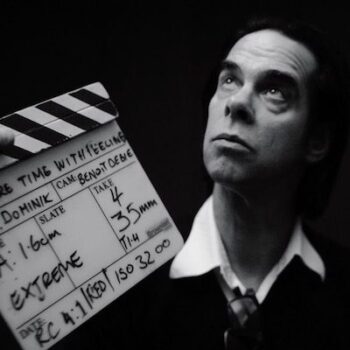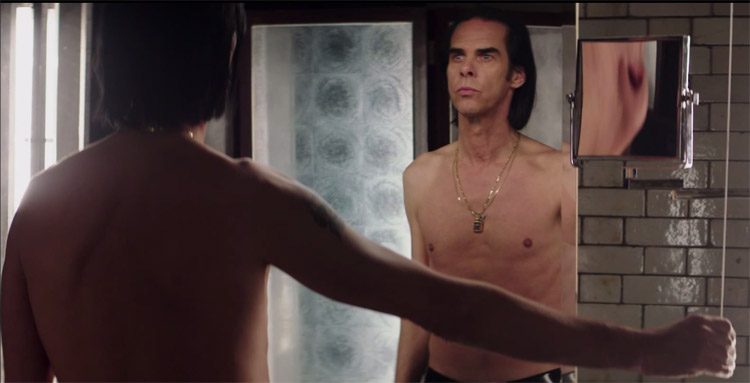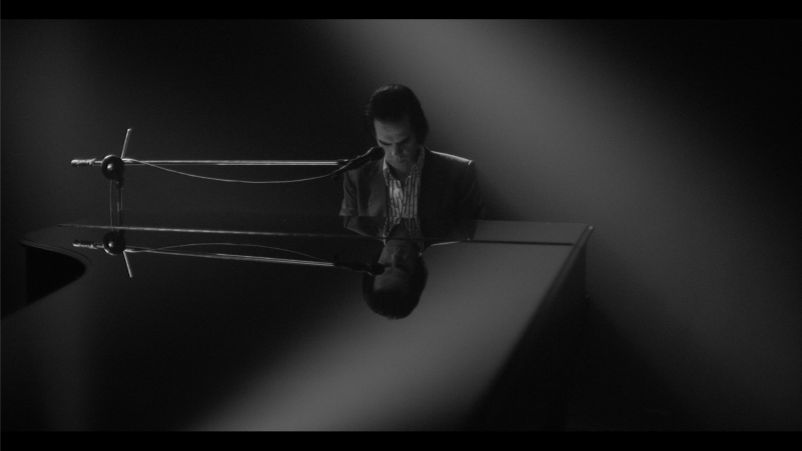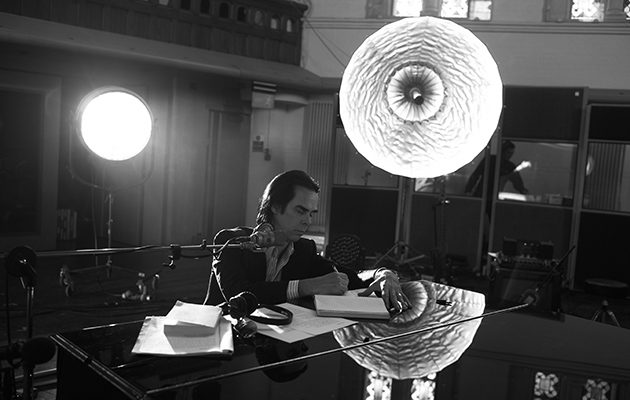
The title of Nick Cave’s new documentary might be a winking acknowledgement that it’s been less than two years since the release of what at first appears to be a similar project, the docudrama 20,000 Days on Earth. The title of the latter pokes fun at the lack of any concrete, catalyzing occasion for the film’s inception. It’s simply a retrospective that’s been affixed to an arbitrary achievement: the first day of filming was Nick Cave’s 20,000th day of life. In general, 20,000 betrays this lack of urgency. One of the last scenes, which shows Cave eating pizza and watching Scarface on a couch with his sons, Arthur and Earl—a scene meant to show that the wild and gloomy artist had entered a staid, peaceful phase of life—took on a haunting quality when Arthur fell to his death from a cliff near Brighton, England, on July 14 of last year. This tragedy is the far more indelible impetus behind One More Time With Feeling, as well as the accompanying album, Skeleton Tree.
When I awoke to read the shocking news last July, I’m ashamed to admit that my sadness was mixed with a touch of speculation—even anticipation—regarding how this unimaginable personal tragedy might be filtered into art through Nick Cave, a man often referred to as rock music’s “Prince of Darkness,” author of some of the bleakest songs I’ve ever heard—“The Mercy Seat,” “Papa Won’t Leave You, Henry,” “Your Funeral My Trial,” and the sardonic “Song of Joy,” to name just a few. I couldn’t have been the only one observing the ensuing public interest over Arthur’s toxicology report (LSD) and the inevitable blame game (Scarface) with mostly revulsion, but also the sick fascination with which our imperfect species tends to greet tragedy-made-spectacle. Cave deems the public fallout barely worth a response in the film, dismissing the media attention as “a complete fuckup, and total bullshit.” I figured at the time that, if we ever heard from Cave again (because permanent silence would have been its own fitting elegy), his next album would either avoid any mention of Arthur or death (thus protecting the musician’s remaining privacy and deriding the catharsis that sick fans like me really wanted) or would stare so deeply into the abyss that the album could only safely be listened to in rooms vacated of sharp objects and abusable substances. One More Time With Feeling maintains a miraculous affective standoff, utterly rejecting sentimentality and platitudes while at the same time offering an ecstatic statement of love’s power over despair.
The film opens with an interview with Warren Ellis, perhaps the most important of Cave’s Bad Seeds since their first collaboration on 1993’s Let Love In. The grittiness of the backseat footage plus Ellis’s reluctance to discuss his friend’s response to Arthur’s death both acknowledge the elephant in the room from the get-go while treating it as illicit, taboo subject matter—an effect heightened when a technical snafu causes the audio to cut off Ellis’s reluctant explanation, “It feels like—”. Then, a death-black screen for ten seconds as Ellis tries to avoid the question, exacerbating the audience’s simultaneous discomfort and eagerness. The film will maintain this tension for twenty minutes, approaching and then swerving away from explicit reference to the tragedy.
The first scene of 20,000 Days on Earth shows Cave waking up in the morning and examining his face in the bathroom mirror; the musician’s first appearance in One More Time also places him in front of a mirror getting ready for the day. One of the pleasures of the former film is a voyeuristic one, the feeling of getting to look into the personal space of the rock star; this pleasure is shown in One More Time to be an artificial one, as the crew offers feedback on his wardrobe choice and directs him to repeat the ritual a second time without any explanation of why the first take needs to be reshot even though it was “perfect.” Cave sighs and obliges, and viewers are left wondering if he’d even agreed to make the documentary—or if the production was foisted on him, a punishing karmic obligation that a celebrity like Cave owes to the world just so they’ll leave him alone. Had the film continued in this vein for too long, it would have been a punishment for viewers as well.
“This is difficult, really fucking difficult,” Cave tells us, seated at the studio piano, and inevitably we think he’s talking about something much bigger than the process of overdubbing vocals. It’s almost like he can’t find the words to speak about “certain events,” until he puts them into song. The first new track we hear, the first track on Skeleton Tree, “Jesus Alone,” gets right to it: “You fell from the sky, crash landed in a field near the River Adur.” Partially because at least some of the song was written and recorded prior to Arthur’s death, “Jesus Alone” does not continue in this vein of direct reflection on the tragedy, the identity of the song’s addressee morphing in a protean fashion: “You’re a young man waking, covered in blood that is not yours. You’re a woman in a yellow dress surrounded by a charm of hummingbirds.”
Supplemental but tied to the film’s elegiac quality is its meditation on the fracturing of narrative. Famed for his songs’ storytelling capacity, Cave admits that his work has been moving in a different direction on the last few albums. “I don’t believe in narrative anymore,” he tells his interviewer. “Events are stuck on top of one another… Time feels elastic these days… A caveman is clubbing his female mate at the same time astronauts are learning how to colonize Mars.” The film fails to follow through on a structural level with this idea of fractured narrative; except for how music video sequences and spoken word interstitials interrupt the traditional documentary genre, One More Time moves in a linear fashion. Simultaneity or asynchronicity relate more to ways in which Arthur’s death intrudes on the present. “There’s this ring around the event, a fence, and we can’t get away from it,” Cave says near the end of the film. “We’re like on a rubber band. It keeps coming back to that thing.” Likewise, don’t expect anything postmodern in the film’s resistance to narrative (such flair could very well have come across as crass given the film’s subject matter), but rather in Cave’s personal refusal to make “narrative sense” out of Arthur’s death, “doing what all the books are saying, distill[ing] it down to a greeting card-sized platitude.” Cave gives one example: He lives on in your heart. “But he doesn’t. He doesn’t live at all.” Trying to do so, trying his death up with language, he claims, “Does him a disservice. It happened to us, but it happened to him.”
However, noting that music is always a linear medium, tied to time, the film’s structural fracturing is more fruitfully articulated as a fluidity of improvisation over the steady generic “rhythm” of documentary pacing. One notable feature of the songs on Skeleton Tree is how Cave’s verses often do not come in “on the one” (as Cave mentions in the film while listening to “Jesus Alone”). In basic terms this means that it’s difficult for a listener to anticipate just when Cave’s voice is going to enter. Even more basically, it’s a difficult album to sing along to. This technique is nothing new to cantabile vocals—rather, pop music has made us very accustomed to internalizing complex synocopations on a minute rhythmic scale—but Cave exaggerates anticipation and delay to such an extent on Skeleton Tree that it takes on a metaphoric quality: the album and the film roil and writhe (watch and listen for it!), a wrestling match with the past that will never result in a victor.
The film evolves as a growing courage to confront the tragedy, not just for Cave, but for his wife Susie Blick and Arthur’s twin brother, Earl. The first flitting footage of Susie reinforces what we learned in 20,000 Days on Earth: despite her previous career as a model, she doesn’t like being photographed. But she’s comfortable enough on camera when she and Earl visit Cave at the studio. Earl acknowledges that it’s “disturbing” to be here, and the filmmakers try to make him more comfortable by offering him a camera he can snap photos with and assuring him that he gets final cut of any footage he’s in. When Cave tells his son about the tedium of filmmaking, all the waiting around it entails, Earl’s reply comes across both heavier and funnier than he planned, a monotone “Sounds really difficult.” One of the most surprising things about One More Time is how funny it can be, far funnier than the super serious 20,000 Days. The first attempts at humor—Cave asking how his hair looks, Warren Ellis replying, “Best it’s ever been—proceed with confidence”—are a little unsettling; Cave had just been musing via voiceover about how one becomes “an object of pity,” and at this point the audience can’t help but worry that our laughter is indeed contaminated with pity. But soon we relax, all of us. “Get rid of it,” Cave tells Susie, in reference to her fur coat, “We’ll have the animal rights people…” And sitting at a mixing table, Cave jokes to his son that the sound engineers let him play around with one that isn’t hooked up. Describing Susie’s compulsion to rearrange furniture, Cave says that sometimes he wakes up and she’s changed the entire function of a room. This humor energizes the film’s life affirming sendoff; after chalking up words as impotent in describing or creating a narrative of or making meaning of his son’s death, and after plumbing his own potential guilt in his son’s accident, Cave ends with, “After a time, Susie and I decided to be happy.” We’re presented with individual shots of the band, the cast, the crew, Cave, Susie, and, last of all, Earl. “It seemed like an act of revenge, of defiance, to care for each other and the ones around us.”
The film’s primary misstep is the same as the album’s, the song “Distant Sky.” This sequence is the only extended part of the film in color, and its effects-heavy journey through the body of Danish soprano Else Torp, coupled with its cosmic pullback (London—England—Europe—our whole sun-crested Superman planet), inject forced profundity and jarring imbalance to lyrics and a melody that already verge on the saccharine. In general, the directing of Andrew Dominik, with whom Cave and Ellis worked on The Assassination of Jesse James by the Coward Robert Ford, and the photography of Benoît Debie and Alwin H. Küchler, is particularly athletic and delicate during the filming of the songs. Plato in reverse, here the sun can be found in the depths of Cave. The studio becomes a Cave-centric galaxy, lit by lunar light diffusers, a dolly orbiting counterclockwise around the singer at his Steinway grand as he plays “Girl in Amber,” reversing its direction for the next song, “Magneto,” the 3D camera eventually spinning off to explore the building’s non-studio space, sliding through walls, dropping down a vertiginous spiral staircase, finding a chink of light in a rotting doorframe.
“We didn’t ask for it,” Cave begins another poetic flight, and again we think he’s talking about something ghastly, “but it’s all around us, a gratuitous beauty.” Later in the film, “There’s no such thing as accidents”—and it turns out the subject matter is his artistic collaboration with Ellis. The peculiar magic of One More Time With Feeling is how these cognitive glitches, these elephant-in-the-room moments, turn our morbid fascination with catastrophe into an invitation—to experience grief’s asynchronous gravity, to understand that even contradictions can be healing, some platitudes revivified: “Everything is not okay,” Cave tells us near the end, “but it is okay. The days go on, and the records go on.”
***
Image credits: feature image, image 1, image 2, image 3, image 4.








